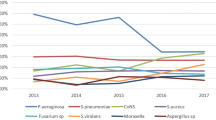Abstract
Background
This is a retrospective, chart-reviewed study of patients diagnosed with infectious corneal ulcers at the Ophthalmology Department of the National University of Asunción in Paraguay. The microbiological culture results are described, as well risk factors for the development of fungal keratitis.
Methods
After obtaining approval from the Institutional Review Board, an analysis of medical charts from 1988 to 2001 was conducted and 660 patients were identified to have been diagnosed with infectious corneal ulcers due to bacteria or fungi. Demographic data were recorded, including age, gender, occupation and geographic location of their home and work (city or rural). Other information collected included the history of the presenting illness, past and current use of ocular medications and whether or not they had a history of trauma or contact lens use. Each patient had an eye examination performed by an ophthalmologist and corneal scrapings were obtained for cultures in all cases. Microbiologic culture results were analyzed.
Results
Twenty-one percent (136/660) of the specimens collected from the patients’ conjunctiva and cornea were sterile in all culture media. Of the 524 (79%) positive cultures, 267 were due to bacteria (51%), 136 to fungi (26%), and 121 (23%) cultures yielded both fungi and bacteria. Of the 430 isolated bacteria approximately 25% (103) were coagulase negative Staphylococcus, followed by 23% (94) Staphylococcus aureus, 14% (60) Pseudomonas aeruginosa and 13% (56) Streptococcus pneumoniae. Acremonium species accounted for 40% (79) of all fungi identified, followed by Fusarium species (15%) (41). Approximately two-thirds of the patients were male (n = 435). For those patients for whom a history was available, approximately half had a history of trauma. Of these, half of these again involved foreign bodies. Over-the-counter medications were used commonly, and most of those patients had a delay in diagnosis of over 1 week. Risk factors for fungal keratitis as opposed to bacterial keratitis were male gender, agricultural occupation, age between 30 and 59, history of trauma and self-medication.
Conclusions
The results of this study provide demographic data on patients with infectious corneal ulcers in Paraguay. Common causes of such ulcers are both bacteria and fungi. Most patients had self-medicated, and most had delayed seeking professional medical care.






Similar content being viewed by others
References
Brilliant LB, Pokhrel RP, Grasset NC, et al (1985) Epidemiology of blindness in Nepal. Bull WHO 63:375–386
Carmichael TR, Wolpert M, Koornhob HJ (1985) Corneal ulceration at an urban African hospital. Br J Ophthalmol 69:920–926
Chirambo MC, Benezra D (1976) Causes of blindness among students in blind school institutions in a developing country. Br J Ophthalmol 60:665–668
Chirambo MC, Tielsch JM, West KP, et al (1986) Blindness and visual impairment in southern Malawi. Bull WHO 64:567–572
Di Bisceglie AM, Carmichael TR (1987) Factors predisposing to central corneal ulceration in a developing population. S Afr Med J 71:769–770
Dunlop AA, Wright ED, Howlader SA, et al (1994) Suppurative corneal ulceration in Bangladesh: a study of 142 cases examining the microbiological diagnosis, clinical and epidemiological features of bacterial and fungal keratitis. Aust NZ J Ophthalmol 22:105–110
Gilbert CE, Wood M, Waddel K, Foster A (1995) Causes of childhood blindness in East Africa: results in 491 pupils attending 17 schools for the blind in Malawi, Kenya and Uganda. Ophthalmic Epidemiol 2:77–84
Gonzales CA, Srinivasan M, Whitcher JP, Smolin G (1996) Incidence of corneal ulceration in Madurai District, South India. Ophthalmic Epidemiol 3:159–166
Hagan M, Wright E, Newman M, Dolin P, Johnson G (1995) Causes of suppurative keratitis in Ghana. Br J Ophthalmol 79:1024–1028
Katz NN, Wadud SA, Ayazuddin M (1983) Corneal ulcer disease in Bangladesh. Ann Ophthalmol 15:834–836
Khan MU, Haque E, Khan MR (1985) Prevalence and causes of blindness in rural Bangladesh. Ind J Med Res 82:257–262
Liesegang TJ, Forster RK (1980) Spectrum of microbial keratitis in south Florida. Am J Ophthalmol 90:38–47
Mahajan VM (1985) Ulcerative keratitis: an analysis of laboratory data in 674 cases. J Ocul Ther Surg 4:138–141
Miño de Kaspar H, G. Zoulek, ME Paredes, et al (1991). Mycotic keratitis in Paraguay. Mycoses 34:251–254
Ormerod LD (1987) Causation and management of microbial keratitis in subtropical Africa. Ophthalmology 94:1662–1668
Rapoza PA, West SK, Katala SJ, Taylor HR (1991) Prevalence and causes of vision loss in central Tanzania. Int Ophthalmol 15:123–129
Smith GT, Taylor HR (1991) Epidemiology of corneal blindness in developing countries. Refract Corneal Surg 7:436–439
Srinivasan M, Gonzalez CA, George C et al (1997) Epidemiology and aetiological, diagnosis of corneal ulceration in Madurai, south India. Br J Ophthal 81:965–971
Thylefors B, Negrel AD, Pararajasegaram R, Dadzie KY (1995) Available data on blindness (update 1994). Ophthalmic Epidemiol 2:5–39
Upadhyay MP, Karmacharya PC, Koirala S, et al (1991) Epidemiologic characteristics, predisposing factors, and etiologic diagnosis of corneal ulceration in Nepal. Am J Ophthalmol 111:92–99
Acknowledgements
The authors thank the Georg-and-Hannelore Zimmermann Foundation and the Department of Ophthalmology at the Ludwig-Maximilian University, Munich, Germany, for their financial and technical support of this study.
Author information
Authors and Affiliations
Corresponding author
Additional information
This article was presented in part at the Paraguayan Congress of Infectology, Asunción, Paraguay, in 0ctober 2001.
Rights and permissions
About this article
Cite this article
Laspina, F., Samudio, M., Cibils, D. et al. Epidemiological characteristics of microbiological results on patients with infectious corneal ulcers: a 13-year survey in Paraguay. Graefe's Arch Clin Exp Ophthalmol 242, 204–209 (2004). https://doi.org/10.1007/s00417-003-0808-4
Received:
Revised:
Accepted:
Published:
Issue Date:
DOI: https://doi.org/10.1007/s00417-003-0808-4




